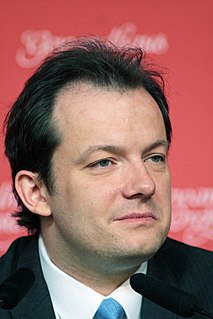
Symphony No. 7 by Gustav Mahler was written in 1904–05, with repeated revisions to the scoring. It is sometimes referred to by the title Song of the Night, which Mahler never knew. Although the symphony is often described as being in the key of E minor, its tonal scheme is more complicated. The symphony's first movement moves from B minor (introduction) to E minor, and the work ends with a rondo finale in C major. Thus, as Dika Newlin has pointed out, "in this symphony Mahler returns to the ideal of 'progressive tonality' which he had abandoned in the Sixth". The complexity of the work's tonal scheme was analysed in terms of "interlocking structures" by Graham George.

Hans Abrahamsen is a Danish composer.
Julian Anderson is a British composer and teacher of composition.
David Sartor is an American composer and conductor of symphonic, chamber, and choral music. He is adjunct professor of music at Middle Tennessee State University, adjunct professor of music at Trevecca Nazarene University in Nashville, Tennessee, and music director of the Parthenon Chamber Orchestra.
The CBSO Youth Orchestra in Birmingham, England is an amateur symphony orchestra for young people managed by the City of Birmingham Symphony Orchestra (CBSO). The orchestra is based at CBSO Centre but performs at Symphony Hall, Birmingham; membership is drawn from the entire Midlands region.
Michael Seal is a British orchestral conductor and classical violinist. Since 2011 he has served as the Associate Conductor of the City of Birmingham Symphony Orchestra (CBSO), having served previously as the orchestra's Assistant Conductor. He is only the second conductor to be given the title of Associate Conductor at the CBSO. The first was Harold Gray who served in that capacity for several decades until his retirement in 1972. In addition to his conducting, Seal played in the violin section of the CBSO from 1992 to 2014.

Andris Nelsons is a Latvian conductor. He is currently the music director of the Boston Symphony Orchestra and the Gewandhauskapellmeister of the Leipzig Gewandhaus Orchestra.
A timpani concerto is piece of music written for timpani with orchestral accompaniment. It is usually in three parts or movements.
Deus ex Machina is a piano concerto by the American composer Michael Daugherty. The 33-minute work was jointly commissioned by the Charlotte, Nashville, New Jersey, Rochester and Syracuse Symphony Orchestras. It won the 2011 Grammy for Best Classical Contemporary Composition for a recording by soloist Terrance Wilson and the Nashville Symphony Orchestra under the baton of Giancarlo Guerrero.
Symphony No. 10 is the tenth symphony by the American composer Philip Glass. The work was commissioned by the Orchestre Français des Jeunes and premiered August 9, 2012, with Dennis Russell Davies conducting the Orchestre Français des Jeunes at the Grand Théâtre de Provence in Aix-en-Provence, France. The piece had its United Kingdom premiere July 31, 2013 at The Proms in Royal Albert Hall.
Heimdall's Trumpet is a concerto for trumpet and orchestra by the American composer Christopher Rouse. It was commissioned by the Chicago Symphony Orchestra for its principal trumpeter Christopher Martin. The piece was completed January 21, 2012 and premiered December 20, 2012 at Symphony Center in Chicago.
At the Speed of Stillness is an orchestral composition in one movement by the British composer Charlotte Bray. The work was commissioned by The Proms for the conductor Sir Mark Elder and the Aldeburgh World Orchestra. It was first performed July 29, 2012 at the Proms by the Aldeburgh World Orchestra under Sir Elder. The piece is dedicated to the British composer Mark-Anthony Turnage.
Caught in Treetops is a concerto for solo violin and chamber ensemble by the British composer Charlotte Bray. The work was commissioned by the Birmingham Contemporary Music Group and Sound and Music. It was first performed on 14 November 2010 at the CBSO Centre, Birmingham by the violinist Alexandra Wood and the Birmingham Contemporary Music Group under conductor Oliver Knussen. The piece is dedicated to the Birmingham Contemporary Music Group.
Foreign Bodies is an orchestral composition in three movements by the Finnish composer Esa-Pekka Salonen. The work was commissioned by the Finnish Broadcasting Company and was first performed at the Schleswig-Holstein Musik Festival on August 12, 2001 by the Finnish Radio Symphony Orchestra under the conductor Jukka-Pekka Saraste.
Circle Map is a composition for orchestra and electronics by the Finnish composer Kaija Saariaho. The work was jointly commissioned by the Royal Concertgebouw Orchestra, the Boston Symphony Orchestra, the Gothenburg Symphony Orchestra, the Orchestre National de France, the Royal Scottish National Orchestra, and the Stavanger Symphony Orchestra. It was first performed at the Holland Festival in Gashouder, Amsterdam on June 22, 2012, by the Royal Concertgebouw Orchestra under the conductor Susanna Mälkki.
Three Illusions for Orchestra is an orchestral triptych by the American composer Elliott Carter. The complete work was given its world premiere in Symphony Hall, Boston, on October 6, 2005 by the Boston Symphony Orchestra under the conductor James Levine.
The Symphony No. 3 is an orchestral composition by the American composer John Harbison. The work was commissioned by the Baltimore Symphony Orchestra under the conductor David Zinman for the orchestra's 75th anniversary. It was given its world premiere on February 26, 1991 by the Baltimore Symphony Orchestra directed by Zinman. The piece is dedicated to Harbison's friend and fellow composer Christopher Rouse.
Left, alone is a piano concerto for the left hand and orchestra by the Danish composer Hans Abrahamsen. The work was commissioned by the Westdeutscher Rundfunk and co-commissioned by the City of Birmingham Symphony Orchestra, the Danish National Symphony Orchestra, and the Rotterdam Philharmonic Orchestra. Its world premiere was given by the pianist Alexandre Tharaud and the Westdeutscher Rundfunk Sinfonie-Orchester under the direction of Ilan Volkov on January 29, 2016. The piece is dedicated to Alexandre Tharaud.









